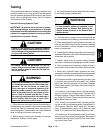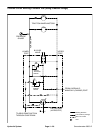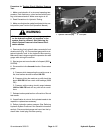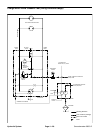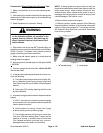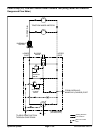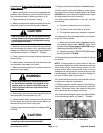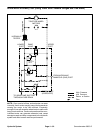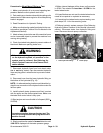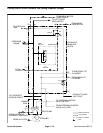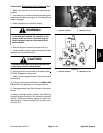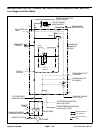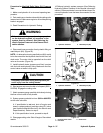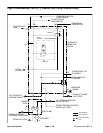
Groundsmaster 3505--D Hydraulic SystemPage 4 -- 31
Procedure for Piston Pump (P3) Flow and T
raction
Relief Pressure
Test:
1. Make sure hydraulic oil is at normal operating tem-
perature. Park machine on a level surface with the cut-
ting units lowered and off. Make sure engine is off.
2. Read Precautions for Hydraulic Testing.
3. Make sure that traction pedal is adjusted to the neu-
tral position (see Traction Unit Operator ’s Manual).
CAUTION
One front wheel will be off the ground during
testing. Makesure machine is supportedso it will
not move and accidentally fall to prevent injuring
anyone under machine.
4. Block up one front traction wheel off the ground to al-
low flow through the traction circuit; disconnect brake
linkage to the raised front wheel (see Adjust Brakes in
the Adjustments section of Chapter 7 -- Chassis).
5. Chock remaining front wheel to prevent movement
of the machine.
6. Attacha heavy chainto therear ofthe machineframe
and something immovable in the shop.
7. Make sure parking brake is on to keep the wheel on
the ground from rotating.
WARNING
Before disconnecting or performing any work
on the hydraulic system, all pressure in the
system must be relieved. See Relieving Hy-
draulic System Pressure in the General Infor -
mation section.
8. Disconnect hose from the lower hydraulic fitting on
the engine side of the hydrostat (Fig. 18).
9. Install hydraulic tester (pressure and flow) in series
with the pump and the disconnected hose. Make sure
the tester flow control valve is fully open.
10.Start engine and move throttle to full speed (3050 +
50 RPM).
CAUTION
During testing, the front wheel on the ground will
be trying to move the machine forward.
11.Slowly push traction pedal fully to forward position.
12.Verify traction relief valve setting by slowly closing
flow control valve on tester. System pressure should be
3000 PSI as the relief valve lifts. Release traction pedal
and open tester flow control valve fully.
13.If relief pressure specification is not met, consider
the following:
A. The traction belt may be worn or slipping.
B. The traction relief valve leaks or is faulty.
C. The hydrostat needs to be repaired or replaced.
14.If the traction relief valve tests properly, verify piston
pump (P3) flow as follows:
A. Slowly push traction pedal in forward direction
until pressure gauge reads 1000 PSI. Verify with a
phototac that the pump speed is 2350 RPM (engine
speed approximately 2450 RPM).
B. Observe flow gauge. TESTER READING should
be approximately 12.5 GPM.
15.Release traction pedal and turn off machine. Record
test results.
NOTE: If charge pressure is good under no load, but
drops below specification when under traction load, the
piston pump and/or wheel motor(s) should be sus-
pected of wear. When a pump and/or motor is worn or
damaged, the charge pump is not able to keep up with
internal leakage in the traction circuit (See Charge Re-
lief Valve Pressure Test in this section).
16.If specifications are not met, the hydrostat needs to
be repaired or replaced as necessary.
17.Relieve hydraulic system pressure (See Relieving
Hydraulic System Pressure in the General Information
section). Disconnect tester from hydraulic fitting and
hose. Reconnect hose to pump connection.
18.Connect brake linkage to wheel (see Adjust Brakes
in the Adjustments section of Chapter 7 -- Chassis).
1. Lower hydraulic fitting 2. Piston pump
Figure 18
2
1
Hydraulic
System





